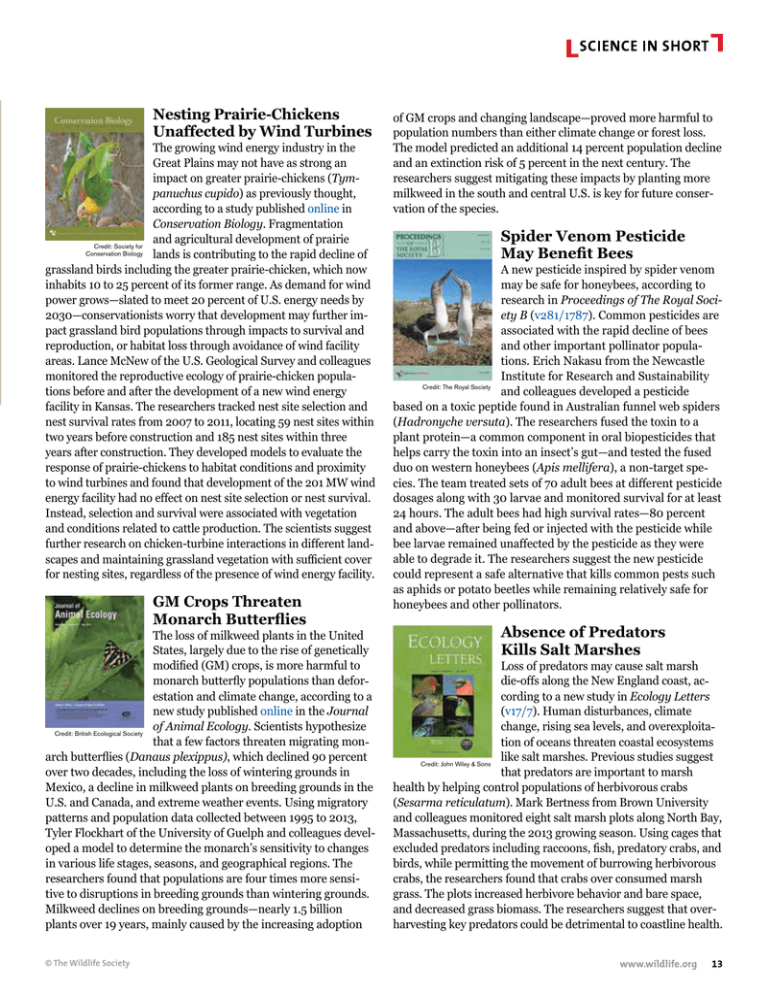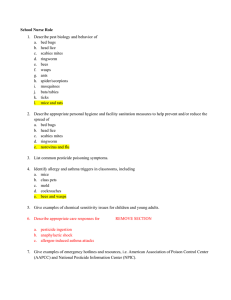Nesting Prairie-Chickens Unaffected by Wind Turbines
advertisement

Nesting Prairie-Chickens Unaffected by Wind Turbines The growing wind energy industry in the Great Plains may not have as strong an impact on greater prairie-chickens (Tympanuchus cupido) as previously thought, according to a study published online in Conservation Biology. Fragmentation and agricultural development of prairie Credit: Society for Conservation Biology lands is contributing to the rapid decline of grassland birds including the greater prairie-chicken, which now inhabits 10 to 25 percent of its former range. As demand for wind power grows—slated to meet 20 percent of U.S. energy needs by 2030—conservationists worry that development may further impact grassland bird populations through impacts to survival and reproduction, or habitat loss through avoidance of wind facility areas. Lance McNew of the U.S. Geological Survey and colleagues monitored the reproductive ecology of prairie-chicken populations before and after the development of a new wind energy facility in Kansas. The researchers tracked nest site selection and nest survival rates from 2007 to 2011, locating 59 nest sites within two years before construction and 185 nest sites within three years after construction. They developed models to evaluate the response of prairie-chickens to habitat conditions and proximity to wind turbines and found that development of the 201 MW wind energy facility had no effect on nest site selection or nest survival. Instead, selection and survival were associated with vegetation and conditions related to cattle production. The scientists suggest further research on chicken-turbine interactions in different landscapes and maintaining grassland vegetation with sufficient cover for nesting sites, regardless of the presence of wind energy facility. GM Crops Threaten Monarch Butterflies The loss of milkweed plants in the United States, largely due to the rise of genetically modified (GM) crops, is more harmful to monarch butterfly populations than deforestation and climate change, according to a new study published online in the Journal of Animal Ecology. Scientists hypothesize Credit: British Ecological Society that a few factors threaten migrating monarch butterflies (Danaus plexippus), which declined 90 percent over two decades, including the loss of wintering grounds in Mexico, a decline in milkweed plants on breeding grounds in the U.S. and Canada, and extreme weather events. Using migratory patterns and population data collected between 1995 to 2013, Tyler Flockhart of the University of Guelph and colleagues developed a model to determine the monarch’s sensitivity to changes in various life stages, seasons, and geographical regions. The researchers found that populations are four times more sensitive to disruptions in breeding grounds than wintering grounds. Milkweed declines on breeding grounds—nearly 1.5 billion plants over 19 years, mainly caused by the increasing adoption © The Wildlife Society of GM crops and changing landscape—proved more harmful to population numbers than either climate change or forest loss. The model predicted an additional 14 percent population decline and an extinction risk of 5 percent in the next century. The researchers suggest mitigating these impacts by planting more milkweed in the south and central U.S. is key for future conservation of the species. Spider Venom Pesticide May Benefit Bees A new pesticide inspired by spider venom may be safe for honeybees, according to research in Proceedings of The Royal Society B (v281/1787). Common pesticides are associated with the rapid decline of bees and other important pollinator populations. Erich Nakasu from the Newcastle Institute for Research and Sustainability Credit: The Royal Society and colleagues developed a pesticide based on a toxic peptide found in Australian funnel web spiders (Hadronyche versuta). The researchers fused the toxin to a plant protein—a common component in oral biopesticides that helps carry the toxin into an insect’s gut—and tested the fused duo on western honeybees (Apis mellifera), a non-target species. The team treated sets of 70 adult bees at different pesticide dosages along with 30 larvae and monitored survival for at least 24 hours. The adult bees had high survival rates—80 percent and above—after being fed or injected with the pesticide while bee larvae remained unaffected by the pesticide as they were able to degrade it. The researchers suggest the new pesticide could represent a safe alternative that kills common pests such as aphids or potato beetles while remaining relatively safe for honeybees and other pollinators. Absence of Predators Kills Salt Marshes Loss of predators may cause salt marsh die-offs along the New England coast, according to a new study in Ecology Letters (v17/7). Human disturbances, climate change, rising sea levels, and overexploitation of oceans threaten coastal ecosystems like salt marshes. Previous studies suggest Credit: John Wiley & Sons that predators are important to marsh health by helping control populations of herbivorous crabs (Sesarma reticulatum). Mark Bertness from Brown University and colleagues monitored eight salt marsh plots along North Bay, Massachusetts, during the 2013 growing season. Using cages that excluded predators including raccoons, fish, predatory crabs, and birds, while permitting the movement of burrowing herbivorous crabs, the researchers found that crabs over consumed marsh grass. The plots increased herbivore behavior and bare space, and decreased grass biomass. The researchers suggest that overharvesting key predators could be detrimental to coastline health. www.wildlife.org 13




